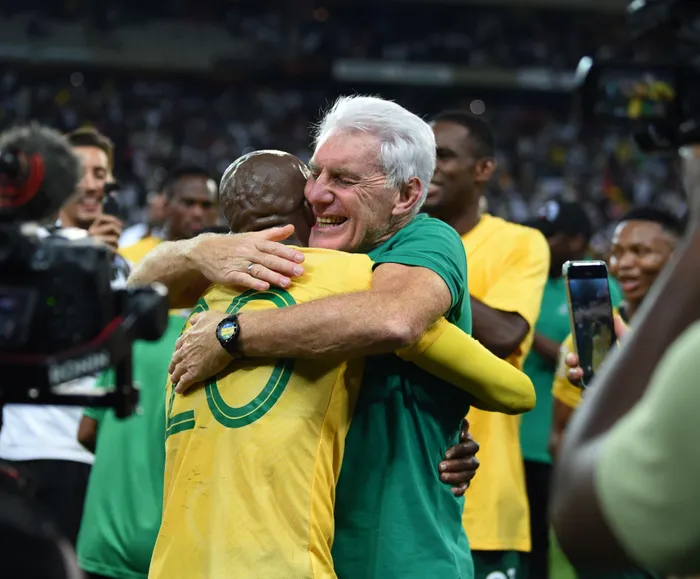Hard-working coaches face pay cuts as SAFA’s financial crisis deepens

The South African Football Association is in serious financial distress. According to reports, the association is preparing to implement salary cuts of between five and 25 percent for top earners, including national coaches Hugo Broos and Desiree Ellis.
Image: BackpagePix / File
BAFANA Bafana and Banyana Banyana have been delivering results that South African football fans can be proud of. Bafana have qualified for the 2026 FIFA World Cup, while Banyana are on top of their Women’s Africa Cup of Nations qualifying group.
Yet behind the scenes, their employer – the South African Football Association (SAFA) – is in serious financial distress. According to reports, the association is preparing to implement salary cuts of between five and 25 percent for top earners, including national coaches Hugo Broos and Desiree Ellis.
The decision has raised eyebrows, not least because the two coaches’ achievements have kept South African football’s reputation intact, while the administrators above them battle to keep the organisation afloat.
Warning signs of collapse
According to a report in Soccer Laduma, SAFA’s National Executive Committee (NEC) held a tense meeting in Mbombela this week, where members agreed to salary reductions for those earning more than R600,000 a year. The move, sources said, follows warnings that the organisation is “on the brink of financial collapse.”
One insider said that “the people earning the most are the ones most angry about the cuts,” but admitted that “SAFA is in trouble – this is about survival now.”
The report described shouting, walkouts and heated exchanges during the meeting. Despite an official statement describing the session as “important for South African football,” no detailed financial figures were released publicly.
Bloated leadership, shrinking resources
SAFA’s financial struggles are not new. As Eliot Mahlase reports in The South African, the association’s finance committee chairperson, Mxolisi Sibam, said its annual turnover is about R250 million, with more than a quarter of that spent on salaries.
In 2022, the organisation reportedly paid R20.8 million in backdated honorariums to its 40-member NEC, averaging R400,000 per person for only two or three years of service. Critics at the time described the payouts as “vote-buying” amid deepening financial instability.
That pattern of overspending has long been under scrutiny. FIFA, in a 2013 letter, instructed SAFA to reduce its NEC to about 18 members, calling its size “unsustainable and inefficient.”
More than a decade later, the structure remains bloated and largely unchanged.
SAFA proposes ‘performance bonuses’ amid pay cuts
In an interview with the SABC, Chairperson of the Association’s finance committee, Mxolisi Sibam, confirmed that SAFA plans to reduce salaries for high earners by up to 25 percent. He said the cuts would be offset by new “performance-based” bonuses that could see employees receive up to 2.5 percent of their annual salary in profitable years.
“We will propose that we reduce their salaries by a percentage ranging from 25% to 5%. However, this will be compensated by the introduction of bonuses, which are quite generous,” Sibam said. “In good years, they could receive a bonus of 2.5% of their annual salary.
“But there is a condition: for us to start paying these bonuses, SAFA must earn revenue of R350 million, excluding any prize money from competitions.”
Sibam warned that if restructuring is delayed further, “SAFA will be liquidated.” He added that the association spends about R60 million annually on salaries and has shown “no financial growth over the last two decades.”
Consider, though, how many of those salaries are actually earned?
Coaches caught in the middle
The proposed cuts come just months after Broos guided Bafana to their first World Cup qualification in over two decades. His contract is due to end six months after the tournament, with uncertainty now surrounding his future, which is a pity.
Meanwhile, Ellis, whose Banyana side continues to carry the flag in African women’s football, remains in dispute with SAFA over her new contract.
For both coaches, the situation must feel like an inversion of reward and accountability – the ones delivering results facing cuts, while those steering the federation into debt remain largely untouched.
Governance still the elephant in the room
SAFA’s leadership has acknowledged that underfunding remains a major challenge. Sibam told the SABC that the problem is not limited to football alone, saying the private sector should “look at football as an enabler.”
But governance issues continue to cloud the association’s image. As Sibam himself conceded, “If we can just look to all the other associations … they don’t hang their dirty linen in public. That causes huge damage and harm to SAFA and our potential to generate revenue.”
Until that self-reflection translates into reform, many will wonder why those who perform on the pitch – rather than those mismanaging the purse strings – are made to carry the cost.
Related Topics: